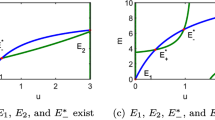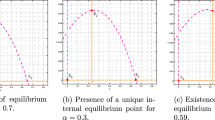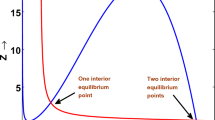Abstract
This paper concerns with a reaction–diffusion system modeling the population dynamics of the predator and prey, in which the predator moves toward the gradient of concentration of some chemical released by prey instead of moving directly toward the higher density of prey. The first objective is to investigate the global existence and boundedness of the unique classical solution. Then we study the asymptotic stabilities of nonnegative spatially homogeneous equilibria. Moreover, the convergence rates are also studied.
Similar content being viewed by others
References
Ainseba, B.E., Bendahmane, M., Noussair, A.: A reaction–diffusion system modeling predator-prey with prey-taxis. Nonlinear Anal. Real World Appl. 9, 2086–2105 (2008)
Amann, H.: Dynamic theory of quasilinear parabolic equations. II. Reaction–diffusion systems. Differ. Integral Equ. 3(1), 13–75 (1990)
Bellomo, N., Bellouquid, A., Tao, Y., Winkler, M.: Toward a mathematical theory of Keller–Segel models of pattern formation in biological tissues. Math. Models Methods Appl. Sci. 25, 1663–1763 (2015)
Grünbaum, D.: Advection–diffusion equations for generalized tactic searching behaviours. J. Math. Biol. 38(2), 169–194 (1999)
He, X., Zheng, S.: Global boundedness of solutions in a reaction–diffusion system of predator–prey model with prey-taxis. Appl. Math. Lett. 49, 73–77 (2015)
Henry, D.: Geometric Theory of Semilinear Parabolic Equations. Springer, Berlin (1981)
Hoefler, C.D., Taylor, M., Jakob, E.M.: Chemosensory response to prey in Phidippus audax and Pardosa milvina. J. Arachnol. 30, 155–158 (2002)
Horstmann, D., Winkler, M.: Boundedness vs. blow-up in a chemotaxis system. J. Differ. Equ. 215(1), 52–107 (2005)
Jin, H.Y., Wang, Z.A.: Global stability of prey-taxis systems. J. Differ. Equ. 262, 1257–1290 (2017)
Kareiva, P., Odell, G.: Swarms of predators exhibit “preytaxis” if individual predators use area-restricted search. Am. Nat. 130, 233–270 (1987)
Ladyzenskaja, O.A., Solonnikov, V.A., Ural’ceva, N.N.: Linear and Quasi-linear Equations of Parabolic Type. Academic Press, New York (1968)
Lee, J.M., Hillen, T., Lewis, M.A.: Continuous traveling waves for prey-taxis. Bull. Math. Biol. 70, 654–676 (2008)
Lee, J.M., Hillen, T., Lewis, M.A.: Pattern formation in prey-taxis systems. J. Biol. Dyn. 3(6), 551–573 (2009)
Lieberman, G.M.: Second Order Parabolic Differential Equations. World Scientific Publishing Co., Inc., River Edge (1996)
Sapoukhina, N., Tyutyunov, Y., Arditi, R.: The role of prey taxis in biological control: a spatial theoretical model. Am. Nat. 162, 61–76 (2003)
Tao, Y.S.: Global existence of classical solutions to a predator–prey model with nonlinear prey-taxis. Nonlinear Anal. Real World Appl. 11(3), 2056–2064 (2010)
Tello, J.I., Wrzosek, D.: Predator–prey model with diffusion and indirect prey-taxis. Math. Models Methods Appl. Sci. 26(11), 2129–2162 (2016)
Wang, J.P., Wang, M.X.: The diffusive Beddington-DeAngelis predator–prey model with nonlinear prey-taxis and free boundary. Math. Methods Appl. Sci. 41, 6741–6762 (2018)
Wang, J.P., Wang, M.X.: Boundedness and global stability of the two-predator and one-prey models with nonlinear prey-taxis. Z. Angew. Math. Phys. 69(3), 63(1-24) (2018)
Wang, M.X.: The diffusive logistic equation with a free boundary and sign-changing coefficient. J. Differ. Equ. 258, 1252–1266 (2015)
Wang, M.X.: A diffusive logistic equation with a free boundary and sign-changing coefficient in time-periodic environment. J. Funct. Anal. 270(2), 483–508 (2016)
Wang, M.X.: Note on the Lyapunov functional method. Appl. Math. Lett. 75, 102–107 (2018)
Wang, M.X., Zhang, Y.: Dynamics for a diffusive prey–predator model with different free boundaries. J. Differ. Equ. 264, 3527–3558 (2018)
Wang, Q., Song, Y., Shao, L.J.: Nonconstant positive steady states and pattern formation of 1D prey-taxis systems. J. Nonlinear Sci. 27, 71–97 (2017)
Wang, X.L., Wang, W.D., Zhang, G.H.: Global bifurcation of solutions for a predator–prey model with prey-taxis. Math. Methods Appl. Sci. 38, 431–443 (2015)
Winkler, M.: Aggregation vs. global diffusive behavior in the higher-dimensional Keller–Segel model. J. Differ. Equ. 248(12), 2889–2905 (2010)
Wu, S.N., Shi, J.P., Wu, B.Y.: Global existence of solutions and uniform persistence of a diffusive predator–prey model with prey-taxis. J. Differ. Equ. 260, 5847–5874 (2016)
Acknowledgements
The authors would like to thank the anonymous referees for their helpful comments and suggestions.
Author information
Authors and Affiliations
Corresponding author
Additional information
Publisher's Note
Springer Nature remains neutral with regard to jurisdictional claims in published maps and institutional affiliations.
This work was supported by NSFC Grant 11771110.
Rights and permissions
About this article
Cite this article
Wang, J., Wang, M. The Dynamics of a Predator–Prey Model with Diffusion and Indirect Prey-Taxis. J Dyn Diff Equat 32, 1291–1310 (2020). https://doi.org/10.1007/s10884-019-09778-7
Received:
Revised:
Published:
Issue Date:
DOI: https://doi.org/10.1007/s10884-019-09778-7
Keywords
- Diffusive predator–prey model
- Indirect prey-taxis
- Global existence and boundedness
- Global stability and convergence rate




